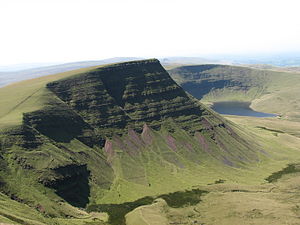Llyn y Fan Fach
| Llyn y Fan Fach | |
|---|---|
 | |
| Location | Brecon Beacons National Park, Carmarthenshire: View from near Picws Du |
| Coordinates | 51°52′55″N 3°44′31″W / 51.88194°N 3.74194°W |
| Type | reservoir, natural lake |
| Primary outflows | River Sawdde |
| Basin countries | United Kingdom |
| Max. depth | 29 m |
| Surface elevation | 506 m |
Llyn y Fan Fach (Welsh meaning "Lake of the small beacon-hill") is a dammed lake of approximately 10 hectares on the northern margin of the Black Mountain in Carmarthenshire, South Wales and lying within the Brecon Beacons National Park. The lake lies at an altitude of approximately 1,660 feet (510 m), immediately to the north of the ridge of the Carmarthen Fans. It is the smaller of two lakes within this mountain massif: the slightly larger Llyn y Fan Fawr is approximately 2 miles (3.2 km) to the east.
Legend of Llyn y Fan Fach

A folklore legend is connected with the lake, known as the Lady of the Lake. In the folk tale,[1] a local young man, son of a widow from Blaen Sawdde (near Llanddeusant) agreed to marry a beautiful girl who arose from the lake, with the condition that he would not hit her three times. He complied easily because the girl was so beautiful, and they were happy for years putting up a house in Esgair Llaethdy near Myddfai, and bringing up a family there. The girl had very special cattle, traditionally still kept at Dinefwr, Llandeilo,[2] and other animals. But over time the man did hit his wife three times, as gentle admonishments. Reasons for why he hit her vary, from the wife laughing at a funeral or crying at a wedding. Regardless, she had to go back to the lake according to the promise, taking the cattle with her. But the mother came back to them to help and instruct her sons, and in particular one called Rhiwallon (in some versions Rhiwallon is the name of the young man who marries the fairy girl). In due course Rhiwallon and the other sons went to the court of Rhys Gryg of Deheubarth, where they became famous doctors who are known today as the Physicians of Myddfai.[citation needed] A number of their medical formulae remain in the Welsh manuscripts.
Access
The lake can be reached on foot via the water board road to the small dam on the lake. There is a car park at the bottom of the single track road reached by a road from Llanddeusant village. The track passes filter beds and associated buildings about halfway up the hill, and there is an unlocked windowless rescue shelter by the wall of the dam. A path continues to the west up the slope to the escarpment, and wooden barriers have been erected here to move the path to one side and allow damaged turf to recuperate. The path follows the edge of the cliff, reaching the summits of Waun Lefrith and then Picws Du, both of which overlook the lake. There are many deep gullies leading down from the cliff top, and numerous rock outcrops near the top. The Beacons Way follows the ridge down from the summits above the lake, and forms an alternative route onto or off the mountain to the dam road. It arrives in Llanddeusant village more directly, and gives access to the Youth Hostel in the village.
Wildlife

There are numerous different species of bird in the area, and they include the red kite, common buzzard, kestrel, carrion crow, common raven and skylark to name a few of the most obvious residents. The former birds can often be found soaring on the updrafts near the cliffs as well as on thermals from the valley below. The red kite was previously restricted to this and adjoining areas in South Wales such as Mynydd Mallaen, mainly as a result of persecution by farmers and gamekeepers, but attitudes have now changed. It was thought that the bird preyed on game birds such as the red grouse, although the evidence showed that they survive mainly on carrion, like many other birds of prey. The red kite has since the 1970s been introduced widely in southern Britain, such as the Chilterns and in many other districts. The kestrel and buzzard are widely distributed, but the raven is restricted to the higher mountains.
Further reading
There are a few versions of the legend of the Lady of the lake in Welsh and English.
- T. Gwynn Jones, Welsh Folklore and Folk-custom (1930; new edition 1979). Tt. 61-4. Background and a lot of interesting details.
